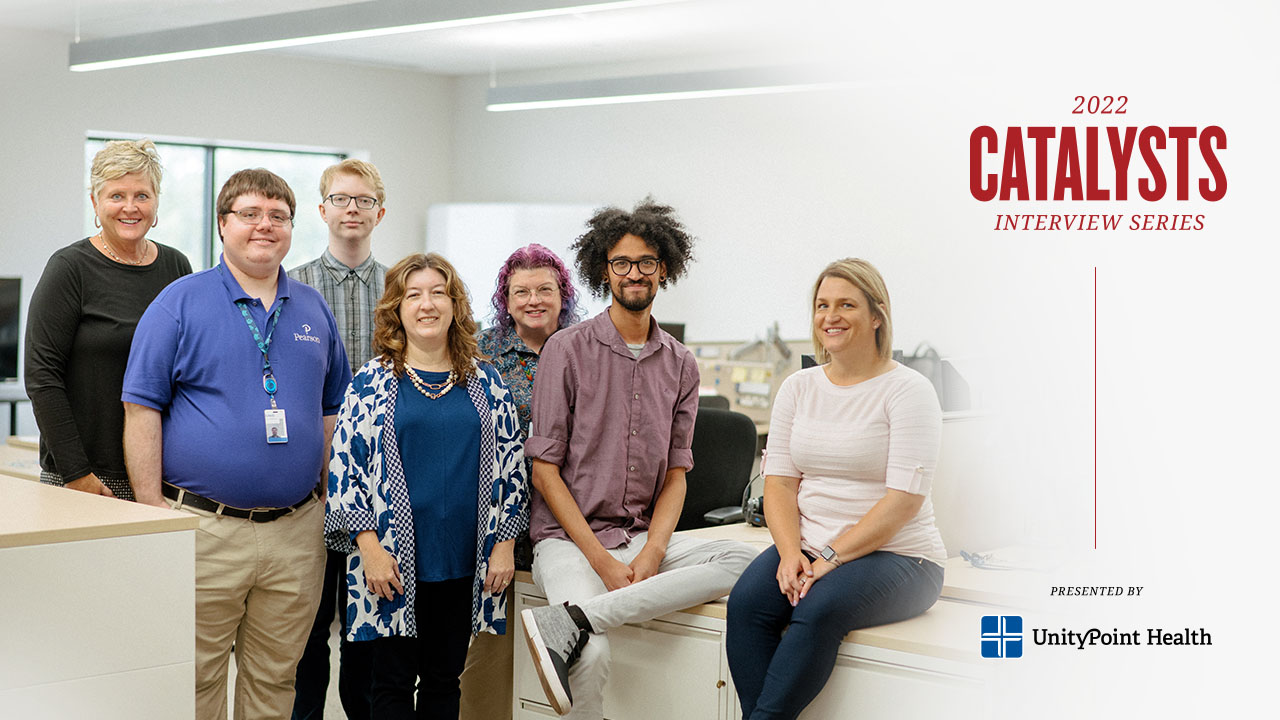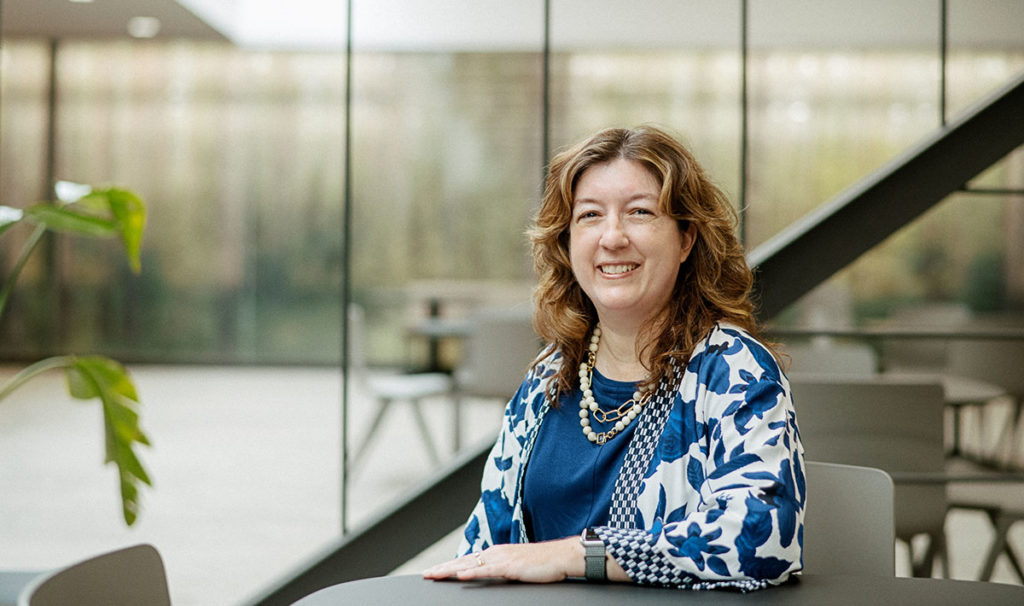
2022 Catalysts Interview – Pearson
It’s evident that Michelle Knedler has a deep-rooted passion for eliminating barriers to entry to the field of tech. At Pearson, she does just that through a number of initiatives she’s involved in within the DEI space. She leads the Learning2Work Pathfinders Apprenticeship program, as well as She’sGotTech, a forum where women can explore their tech curiosities in a collaborative and fun female environment.
The Technology Association of Iowa connected with Michelle to learn more.
You’re the program manager for Pearson’s Learning2Work Pathfinders Apprenticeship program. Tell us a bit more about that and how it contributes to the company’s overall DEI efforts.
The idea behind apprenticeships is to offer people an education pathway that allows them to learn on the job, while earning a living.
Basically, instead of looking to hire people straight out of college or with many years of experience, we provide a framework for people to acquire professional skills by working side-by-side with experts to solve our business problems. Part of their journey includes a rotation system that allows them to learn about different specialties in tech so that they can find their niche and be placed in a permanent job.
What I find inspiring about this program is how diverse the people in the program are. This isn’t just for people who have recently graduated from high school. It’s for anyone who has a drive to work in tech. Some people have struggled in traditional classroom settings, while others are just ready for a career shift.
I think it’s safe to say that DEI is more than a tagline for us. If you join any of our meetings, you’ll likely be part of a respectful but spirited discussion. For example, when the group was creating an app prototype, they chose a color palette that I believed would not go over well with boys. I was very wrong. Both the boys and girls loved it. I initially believed that we should focus on gender differences, but actually there was a generational difference.
This experience highlights that there is a big difference between designing solutions for people versus with people who are different than yourself.
What I find inspiring about this program is how diverse the people in the program are. This isn’t just for people who have recently graduated from high school. It’s for anyone who has a drive to work in tech. Some people have struggled in traditional classroom settings, while others are just ready for a career shift.
- Michelle Knedler
You’re also involved with She’sGotTech, a forum where women can explore their interest in tech. Can you share more about that?
It’s definitely something that I’ve been wanting to start for years. I believe that there are ways to address the gender gap in technology, so that more women have a voice in the products we create.
Pearson has more than 20,000 employees, and a lot of women are seeking opportunities to either find their next passion or stay competitive in the market by upskilling themselves. But, finding the time and perhaps even more importantly, having a network of people that understand them are critical factors. Programs like this help give women that space to learn in the company of women.
She’sGotTech at Pearson is both an internal program and external. Our internal program is focused on monthly tech workshops that cover a wide range of technology concepts, such as agile development practices, data analytics and cloud infrastructure. It’s important that the sessions are bite sized so that women can easily fit them into their work schedules, and every session includes hands-on activities.
The all-female design has resulted in some men questioning why this is necessary. It can be perceived as a lack of inclusivity. The truth is that it’s effective. More women will attend and actively participate when they feel that they don’t have to hide what they don’t know. When you feel a sense of belonging, it’s easier to focus on the thing at hand – learning. Each month more and more women are attending which tells us we’re on the right course.
This is how one of our participants described her experience in the program: “I feel excited and hopeful! I think platforms such as this, women helping women, is the need of the hour and helps fill a void of learning that many of us appreciate.”

I believe that there are ways to address the gender gap in technology, so that more women have a voice in the products we create.
- Michelle Knedler
It sounds like you’re especially passionate about women in tech. Why did you personally get into the field?
I went to school at the University of Northern Iowa. When I started, I didn’t know precisely what I wanted to do. Sometimes the default is to go with what you’ve seen, so I started as an education major, but I knew that wasn’t the right fit.
During my sophomore year, I thought about my dad, who’s an engineer. I think that’s very common with girls – that the person who gets them involved in engineering is their dad, who also might be in the field. So, I started taking engineering courses, and what I experienced was what women still experience today, which is going into a classroom that’s 90% male and you’re coming in behind.
A lot of men become interested in tech early on in their life. When I speak to students or men in the field, they frequently describe how their interests started by playing games. That then inspired them to code their own games.
When women enter that first door to get into tech, it’s extremely intimidating. A lot of times we’re in over our heads, and we’re afraid to ask questions. I think my experience mirrors a lot of women.
It’s great that you’re able to share your experiences as a woman in tech with others who are entering the field.
Yeah. I mean it’s a little crazy that I graduated 25 years ago, and today’s stats are basically the same – 18 to 19% of computer science majors are women. And in 25 years they have not shifted.
So, we’re just trying to find effective means to get women into tech. With She’sGotTech, I want to focus a lot of our community outreach on high school girls. I think a lot of people believe that high school students have their futures figured out. I have a 17-year-old and a 20-year-old. I know firsthand that kids leaving high school struggle with matching their interests and talents with careers.
I think the biggest hurdle we face with getting more girls interested in careers in tech is changing their misconceptions. Common misconceptions range from females not having the aptitude to be engineers to careers in tech being perceived as not collaborative and creative fields.
This summer we started chipping away at these stereotypes in our She’sGotTech Careers in Tech workshop. It was amazing to watch the girls’ perspectives on tech evolve during the week, as they learned about inclusive design.
What’s the overarching impact you hope to have through your work on DEI efforts at Pearson?
I hope to change peoples’ lives. I think there’s a segment of society that is overlooked, and their talents are underutilized.
When we recruit for the apprenticeship program, we have people apply who already have two- and four-year degrees in computer science who have been trying to break into the industry for years.
One reason is that the traditional interview process isn’t always the best measure of a person’s ability, not to mention the challenges that a neurodivergent person may contend with. Lack of experience is another factor that many people who start tech late face. It’s the whole, you need experience to get experience dilemma.
We address these issues in our program by conducting a multi-day hiring workshop. We spend a lot of time getting to know the candidates, observing how they work together and evaluating the work products that they create.
I also hope we have an impact on education, offering more experiential learning opportunities. Whether graduating from high school or college, students should have an understanding of how their learning connects to the real world.
In my opinion, tech requires diversity to make products that we all want to use. So that’s one of the biggest selling points behind diversity in tech is that we all have our special needs, and we need different perspectives.
- Michelle Knedler

